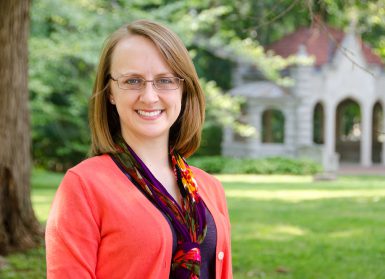Myrick part of IU team researching health in mining towns

Assistant professor Jessica Gall Myrick will address the connection between public health and communication in small West Virginia mining towns in a research project funded by the National Institutes of Health.
Myrick and three other IU researchers – Michael Hendryx of applied health science in the School of Public Health, and Marta Venier and Amina Salamova of the School of Public and Environmental Affairs – received a two-year grant for more than $470,000 from the NIH earlier this year.
The project, Assessing Air Pollution Exposures Among a Vulnerable Rural Disparities Population, will assess the difference between environmental conditions and health parameters in groups living in close proximity to mining operations compared to those at least 40 miles away from mining.
The researchers will seek to learn whether people who live in coal mining communities are exposed to pollutants associated with increased risk of respiratory and cardiovascular diseases and cancer.
The team chose rural West Virginia because their research has indicated that ambient air quality is significantly worse in mining towns than that of control towns that lack the mining presence.
The subjects will be local high school students, whom Myrick and the team will recruit in person during visits to the high schools. Research subjects will wear silicone wristbands that absorb chemicals to track the environmental affects, said Myrick.
“It’s a really good way of what we call passively tracking exposure,” she said. “People don’t have to record everything.”
Venier and Salamova, both research scientists at SPEA, have studied the persistence of flame retardant chemicals in the environment, while Hendryx, who lived in West Virginia for several years, has published a series of epidemiological studies about chemicals in mining communities.
Myrick’s position in the research focuses on communication both indirectly and directly. Indirectly, it comes into play as Myrick hopes word-of-mouth communication will engage and connect the students and help them understand the importance of science.
In the direct sense, she will conduct focus groups and interviews with students wearing the bands, and she has created a detailed questionnaire to ask them how they get their information about health as a means of best knowing how to communicate the results to them.
She noted the importance of coal to these communities and lack of connections to the rest of the world, particularly in terms of Internet accessibility.
“Coal is really an essential part of the economy in this part of the country, and there’s a long history and a proud history of helping to basically power America through the coal that’s mined in this part of the country,” Myrick said.
As a result, the research will require close analysis and consideration of how residents of the area best respond to news about health.
“You can’t just go in and say, ‘Look, coal might hurt your health,’ and expect everyone to be really open to that,” she said. “We have to be really strategic in how we communicate this information back in a way that hopefully will be helpful.”
Myrick’s research focuses on health communication and how to communicate health information through media, particularly in how that information translates into and influences human behavior.
More:

